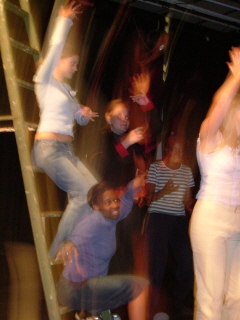HIV/AIDS Introductory Workshop/Suggested HIV/AIDS Workshop Structure and Activities/Welcome and Warm-up
Suggested HIV/AIDS workshop structure and activities
Section 1: Warm-up and welcome
A. Welcome
Everyone should make and wear a nametag.
As facilitator, introduce yourself and give a little of your background that helps the learners to understand the experience you bring with you.
Briefly outline what will happen during the day.
Tip: You may want to write up the headings of the different sections onto a chalkboard or sheet of newsprint. You can then cross off each section as you complete it. This helps the learners to locate themselves within the process. It also breeds a sense of accomplishment.
B. Song and prayer
Some background: Most of my target learner groups come from cultures in which song and prayer are strong unifying forces. If this descibes your learner group, then it helps to create a sense of group cohesion and focus if you begin each session with a song and a prayer initiated and lead by the learners.
C. Warm-up and ice-breakers
Warm-up activities are vital! And yet we so often leave them out. As this workshop is very participatory, experientialand holistic, leaving out the warm-up will mean that your learners are less ready and more reluctant to participate. A good warm-up will energise the learners, help them to bond with each other, create a sense of excitement and anticipation, focus their concentration and can introduce some of the major themes of the session.
There are three warm-up activities here, and you can add or substitute your own to meet the specific needs of your learner group.
Clapping circle: I am ... and I feel ...Purpose To introduce names and the idea that the feelings of each individual are important. Process The learners stand in a circle facing inwards. Set up a clapping and/or clicking rhythm. Into this rhythm each learner will chant: I am (his/her name) and I feel (the main feeling s/he is experiencing at the beginning of this course.) Everyone in the group has a chance to do the chant. You can also repeat the activity with the group repeating the chant after each individual
|
Serious / delighted greetingPurpose To introduce learners to each other and to break down physical barriers. Process Tell the learners that they are going to greet everyone in the group in a special way. Demonstrate the greeting for them - You may wish to choose the most stern looking person in the group to break the ice. First they will greet each other very seriously, shaking hands and saying: I am (name). As they are doing this they realize, I know this person! This is my friend! They cry out each other’s names in delight and embrace with much backslapping.
|
Jazz breaksPurpose To energise the group and to introduce and promote harmonious group work. Process The learners stand in a circle facing inwards. Ask the group to describe Jazz music. The key ideas that need to emerge are: A beat, various instruments, and improvisation within a common theme. Tell the group that they are going to create a Jazz band using their bodies and voices. Set up a unified stamping rhythm into which the music will be played. Each person will be a different instrument of his/her own choosing. Each instrument must play continuously while listening to and harmonizing with the others. Each learner adds his/her instrument. Conduct the band. Keep the music playing until all have learned to listen to each other and work with the group.
|
D. Establishing the ‘safe’ environment
HIV/AIDS is often a difficult, emotional and/or embarrassing topic for people to explore. To help smooth the process, it is a good idea to establish some ground rules. Here is an activity that will help your group collaboratively to create some boundaries for behaviour during the session.
Creating a Class CulturePurpose To establish an agreed upon set of rules to guide the learners’ behaviour towards each other during the workshop session/s. Process Ask the learners to explain what culture is. Key ideas that need to emerge are: A set of rules or norms that guide behaviour, it is shared by people of the same background, it creates a sense of shared identity. Tell the learners that as a group you are going to create a Class Culture to guide everyone’s behaviour during the workshop/s. Ask the class: What can we do to make sure we work well together as a group who are studying a difficult, sad and sometimes embarrassing issue? Buzz groups: Pairs to come up with some ideas to answer this question. Feedback: Each buzz group feeds back one idea until all are written up onto newsprint. Discussion: Lead a discussion to make sure that the list contains rules and ideas that everyone can agree with and that it contains a comprehensive set of guidelines. Enforcement: Ask the class who will be responsible for enforcing this culture and what the penalties for breaking the code will be. Try to encourage the process to involve peer enforcement with something beneficial to all, like tea-making duties, as the punishment. Commitment: Once the whole class has agreed to the list, each learner signs the list to show commitment to the class culture. Note: This document should stay pasted up throughout the workshop (and longer programme) so that it can be referred to when needed. Ideas that you could include in the Class Culture list:
|
